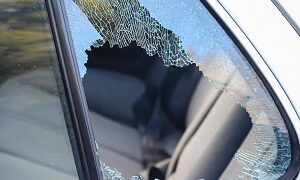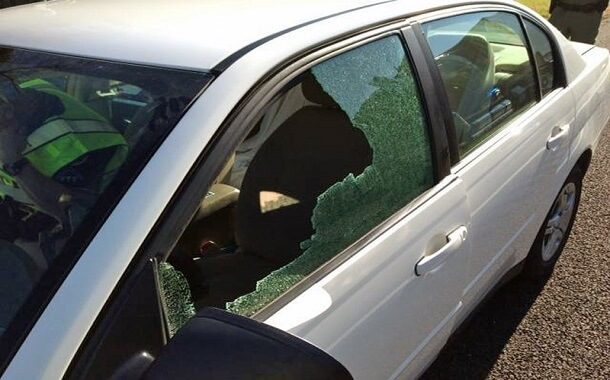How Much Does Passenger or Driver Side Window Replacement Cost?
Last Updated on March 17, 2024
Written by CPA Alec Pow | Content Reviewed by ![]() CFA Alexander Popinker
CFA Alexander Popinker
Cracked or broken car windows are more than just an eyesore. They can compromise your safety and allow weather or security breaches. That’s why prompt window replacement is essential. But what should you budget for a new driver or passenger side window? This guide examines the factors influencing costs so you can make informed repairs.
Few things are more annoying than discovering a cracked vehicle window. Small fractures steadily worsen, while major damage necessitates immediate replacement. Driving with impaired visibility or broken glass raises safety issues. Beyond cost, acting quickly protects you on the road.
How Much Does Passenger or Driver Side Window Replacement Cost?
Replacing a damaged car window isn’t necessarily cheap, with prices ranging from $200 for a basic repair up to $1,000+ for more complex jobs. However, ignoring the problem escalates costs and risks over time. Read on to learn more about budgeting for passenger or driver side window replacement.
Driver Side Window Replacement Costs
For basic driver side window replacement, expect to pay $250 to $450 on average. More complex jobs with added steps or parts cost $500 to $800+.
Factors impacting driver side pricing include:
- Window type – Manual or power windows have different replacement requirements.
- Features – Built-in defrosters, tinting or other extras add cost.
- Vehicle make – Labor rates and OEM parts vary between automakers.
- Damage extent – Just the glass, or regulator or motor issues too?
- DIY or professional – Professional installation costs more but is often worth it.
Compare local repair shop quotes to make the most economical choice for your needs.
Torque News, for example, shares a personal experience regarding the cost to replace a Chevy Bolt EV’s windshield. The total cost for replacing the windshield was $576.87, broken down into the cost of the windshield itself, service fees for technician installation, disposal fees, and taxes.
Passenger Side Window Replacement Costs
Expect to spend $200 to $600 for basic passenger window replacement. High-end parts or extensive work may cost up to $800.
Passenger side window replacement costs take into account:
- Less mechanical equipment than the driver side in most vehicles.
- Potentially simpler installation since the driver seat isn’t in the way.
- Ability to negotiate insurance deductible if damage results from an accident.
- The difference in glass specifications between front and rear passenger windows.
While marginally cheaper overall, passenger side repairs still require care and expertise.
Overview of Damage to Your Vehicle’s Windows
Several types of damage may prompt window replacement:
- Cracks – Small fractures spread progressively in the wind.
- Chips – Surface damage often caused by flying debris.
- Shattering – More severe damage where the glass breaks apart.
- Scratches – Light abrasions or deeper grooves weaken the glass.
Causes range from debris strikes and vandalism to manufacturing defects under warranty. If you notice any damage, have it assessed promptly to avoid worsening.
Factors that Determine Replacement Costs
From the vehicle itself to local labor rates, many factors influence window replacement pricing:
- Vehicle make and model specifies required OEM parts.
- Driver vs. passenger side and front vs. rear windows determine complexity.
- Mechanics of window – motor, regulator and sensors complicate installation.
- Professional labor rates range widely based on shop location.
- Aftermarket vs OEM glass affects material costs.
- Extent of damage to window components increases labor and parts.
Insurance and Warranties
Two resources that may cover repair costs include:
- Auto insurance – Covers damage from collisions; subject to deductible.
- Replacement warranties – Aftermarket glass and some motors/regulators carry 1-year warranties.
When using insurance:
- Review policy details to understand your deductible amount and coverage limits.
- Obtain approval from your insurer before proceeding with repairs.
- Ask about using aftermarket glass vs. OEM to reduce claim costs.
You might also like our articles about the cost of fixing a keyed car, window tint removal, or sunroof installation.
How to Choose a Quality Auto Glass Replacement Shop
Seeking estimates from 3-4 shops helps identify the best value. Look for:
- Technicians certified in auto glass replacement.
- Positive customer reviews praising service and pricing.
- A facility close to your location for convenience.
- Quick turnaround time so you aren’t driving with damaged glass long.
- A lifetime warranty on glass parts and competitive labor rates.
Doing some research prevents overpaying or choosing disreputable services.
Prevention and Maintenance Are Important
Avoid the cost and hassle of replacement by:
- Parking carefully away from other cars to prevent door dings.
- Removing debris like tree sap to stop etching and erosion.
- Fixing small chips promptly to halt cracking.
- Checking window mechanics for smooth operation.
- Replacing wiper blades regularly to maximize visibility.
With some care and diligence, your vehicle’s glass should last for years before needing replacement.
The Benefits of Prompt Repair
Don’t put off fixing damaged windows. Addressing issues quickly:
- Improves driving safety with full visibility.
- Prevents further cracks from developing.
- Restores your vehicle’s structural integrity.
- Maintains climate control and keeps the elements out.
- Upholds aesthetic appeal and resale value.
- Avoids citations for vehicle defects (depending on local laws).
Taking action at the first sign of damage makes the most sense financially and for your safety.
Frequently Asked Questions
Which car window is cheapest to replace?
 The rear passenger side window is usually the cheapest car window to replace. Prices start around $150. This is because:
The rear passenger side window is usually the cheapest car window to replace. Prices start around $150. This is because:
- Rear windows are smaller and require less glass material.
- Rear passenger windows have no mechanical parts like motors or regulators.
- Rear windows do not impact visibility or safety as directly as windshields or front side windows.
- Accessing the rear window does not require working around front seat placement.
So if your budget only allows fixing one damaged window, start with the rear passenger side as it will cost the least. Just keep in mind that leaving other windows cracked or broken lowers your safety and car value.
What are the side windows on a car called?
The side windows on a car include:
- Driver’s side front window
- Passenger side front window
- Driver’s side rear window
- Passenger side rear window
The front side windows are also called door windows since they are part of the front door assembly. Some cars also have quarter windows mounted just behind the rear side windows along the C pillar. The side windows provide visibility and allow air circulation while driving.
Are all car windows the same size?
No, different car windows have varying sizes:
- Windshield – The largest piece of glass on a car. Size depends on car model but may be over 5 feet wide.
- Front side windows – Door windows are smaller than windshields but larger than rear windows. Around 2 feet wide.
- Rear windows – Tend to be the smallest at 1-2 feet wide. Coupe rear windows are larger.
- Quarter windows – Extend visibility on some models. Under 1 foot wide.
- Sunroofs – Can be fixed glass or retractable. Sizes range widely based on car style.
While windshields are consistently the largest, other window dimensions vary between makes and models. Windows are carefully engineered to provide visibility while matching the overall vehicle design.



Leave a Reply
Want to join the discussion?Feel free to contribute!